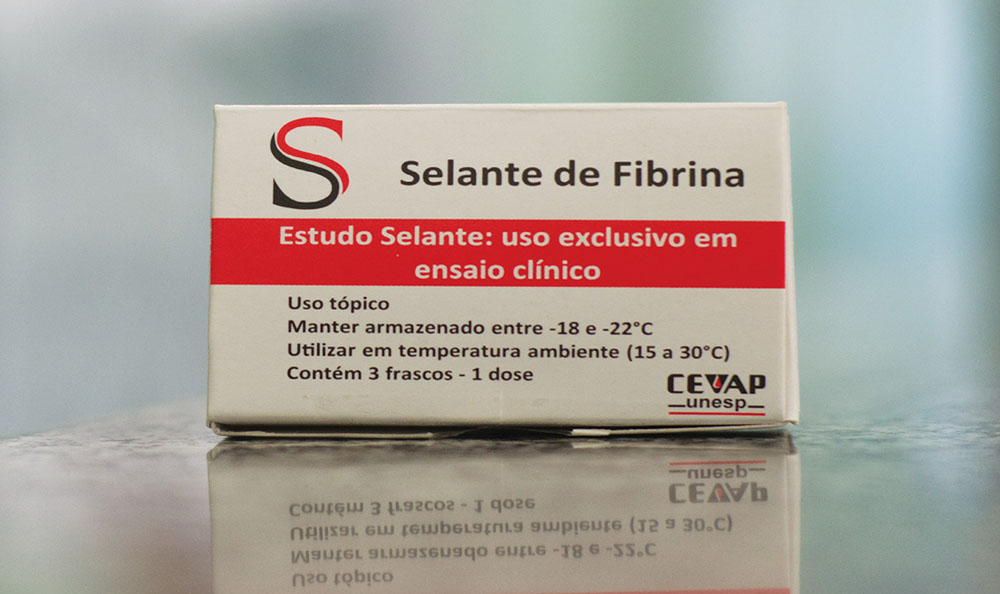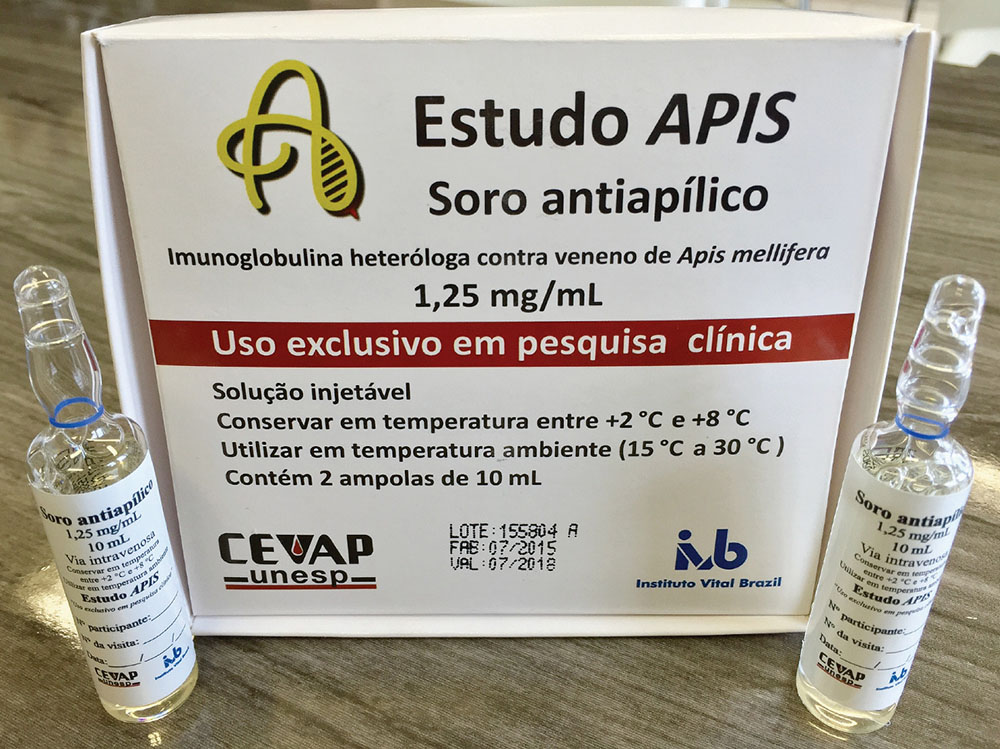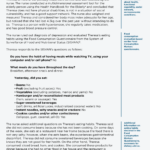Benedito Barraviera, Full Professor, Center for the Study of Venoms and Venomous Animals (CEVAP), São Paulo State University (UNESP), Botucatu, SP, Brazil.
 The Center for the Study of Venoms and Venomous Animals (CEVAP) of UNESP, since its launch in 1993, aims to develop translational research by working from bench to bedside with biopharmaceuticals derived from animal venoms.
The Center for the Study of Venoms and Venomous Animals (CEVAP) of UNESP, since its launch in 1993, aims to develop translational research by working from bench to bedside with biopharmaceuticals derived from animal venoms.
Pursuing such goal, in 2010, support was received from the Department of Science and Technology (Decit) of the Brazilian Ministry of Health to finance the phase I/II clinical trial Treatment of chronic venous ulcers with fibrin sealant derived from snake venom. In 2013, another phase I/II clinical trial was approved by Decit, the “Treatment of envenoming by massive Africanized honeybees (Apis mellifera) stings with the new apilic antivenom”. Both trials were previously approved by the National Committee on Research Ethics (CEP/CONEP), were recognized by Anvisa and ended in 2019.
All reports concerning those clinical trials were sent to the respective regulatory bodies and results were published in peer-reviewed journals of high impact factor1, 2, 3, 4. The following videos give further information on the process of developing and producing both products.
Video 1. The fibrin sealant developed by CEVAP/UNESP.
Video 2. The apilic antivenom developed by CEVAP/UNESP.
The accumulated experience in the development of these biopharmaceuticals for the last ten years has stimulated the next challenges that include carrying out the phase III clinical trials. Therefore, samples produced in pilot scale must follow good manufacturing practices (GMP). Since up to this moment there is no available infrastructure in Brazil for the production of such samples, the researchers of CEVAP submitted to the Ministry of Health a project to build a Factory for the Production of Pilot Batches for Clinical Research5, which was approved in 2019. In February of 2022, the construction of this facility has begun on Lageado Experimental Farm, an UNESP campus in Botucatu, SP.
The creation of both biopharmaceuticals has broaden the horizons of public universities in Brazil, making possible the construction of a contract development and manufacturing organization (CDMO) in a research center. Thus, CEVAP will become soon an “industry” with two clear branches: an educational facility that will train professionals capable of working on the production chain of biological products from bench to bedside; and an “industrial” facility for the production of biopharmaceutical samples for clinical research, both for public and private initiatives.
This pioneering initiative in Latin America will contribute to the formation of professionals capable of crossing the “death valley”6, 7, 8 and to the establishment of biopharma innovation ecosystems that will, in turn, create startups that will bring more wealth to the country9.

Image: Author.
Figure 1. Packaging of the fibrin sealant developed by CEVAP/UNESP. Image by CEVAP/UNESP.

Image: Author.
Figure 2. Packaging of the apilic antivenom developed by CEVAP/UNESP. Image by CEVAP/UNESP.
Read more
- ABBADE, L.P.F., et al. Chronic venous ulcers: a review on treatment with fibrin sealant and prognostic advances using proteomic strategies. Journal of Venomous Animals and Toxins including Tropical Diseases [online]. 2020, vol. 26, e20190101 [viewed 7 June 2022]. https://doi.org/10.1590/1678-9199-jvatitd-2019-0101. Available from: https://www.scielo.br/j/jvatitd/a/NdNG8sKf9ddRtdvbsp3VSrR/
- ABBADE, L.P.F., et al. Treatment of chronic venous ulcers with heterologous fibrin sealant: a phase I/II clinical trial. Frontiers in Immunology [online]. 2021, vol. 12, 627541 [viewed 7 June 2022]. https://doi.org/10.3389/fimmu.2021.627541. Available from: https://www.frontiersin.org/articles/10.3389/fimmu.2021.627541/full
- BARBOSA, A.N., et al. A clinical trial protocol to treat massive Africanized honeybee (Apis mellifera) attack with a new apilic antivenom. Journal of Venomous Animals and Toxins including Tropical Diseases [online]. 2017, vol. 23, no. 1, 14 [viewed 7 June 2022]. https://doi.org/10.1186/s40409-017-0106-y. Available from: https://jvat.biomedcentral.com/articles/10.1186/s40409-017-0106-y
- BARBOSA, A.N., et al. Single-arm, multicenter phase I/II clinical trial for the treatment of envenomings by massive africanized honey bee stings using the unique apilic antivenom. Frontiers in Immunology [online]. 2021, vol. 12, 653151 [viewed 7 June 2022]. https://doi.org/10.3389/fimmu.2021.653151. Available from: https://www.frontiersin.org/articles/10.3389/fimmu.2021.653151/full
- FERREIRA, R.S., et al. Launching a CDMO in Brazil aiming to develop biopharmaceuticals for clinical trials. Journal of Venomous Animals and Toxins including Tropical Diseases [online]. 2022, vol. 28, e20220017 [viewed 7 June 2022]. https://doi.org/10.1590/1678-9199-jvatitd-2022-0017. Available from: https://www.scielo.br/j/jvatitd/a/bR7KGg6xkj6wTmhgcXGx4NH/
- GAMO, N.J., et al. Valley of death: A proposal to build a “translational bridge” for the next generation. Neuroscience Research [online]. 2017, vol. 115, pp. 1-4 [viewed 7 June 2022]. https://doi.org/10.1016/j.neures.2016.11.003. Available from: https://www.sciencedirect.com/science/article/abs/pii/S0168010216302474?via%3Dihub
- SEYHAN, A.A. Lost in translation: the valley of death across preclinical and clinical divide – identification of problems and overcoming obstacles. Translational Medicine Communications [online]. 2019, vol. 4, no. 1 [viewed 7 June 2022]. https://doi.org/10.1186/s41231-019-0050-7. Available from: https://transmedcomms.biomedcentral.com/articles/10.1186/s41231-019-0050-7
- WOOLSTON. C. Researchers’ career insecurity needs attention and reform now, says international coalition. Nature [online]. 2021 [viewed 7 June 2022]. https://doi.org/10.1038/d41586-021-01548-0. Available from: https://www.nature.com/articles/d41586-021-01548-0
- BETTANTI, A., LANATI, A. and MISSONI, A. Biopharmaceutical innovation ecosystems: a stakeholder model and the case of Lombardy. The Journal of Technology Transfer [online]. 2021 [viewed 7 June 2022]. https://doi.org/10.1007/s10961-021-09890-1. Available from: https://link.springer.com/article/10.1007/s10961-021-09890-1
To read the article, access
GATTI, M.A.N., et al. Treatment of venous ulcers with fibrin sealant derived from snake venom. Journal of Venomous Animals and Toxins including Tropical Diseases [online]. 2011, vol. 17, no. 2, pp. 226-229 [viewed 7 June 2022]. https://doi.org/10.1590/S1678-91992011000200015. Available from: https://www.scielo.br/j/jvatitd/a/qLtYtwZR9bcqwQSrWcr9wpJ/
Link(s)
Social media – CEVAP/UNESP: Facebook | Twitter
CEVAP/UNESP | Institutional video | 2020
CEVAP/UNESP | Signing Ceremony | Manufacturing Plant for Production of Clinical Research Samples
Social Media – JVATITD: Facebook | Twitter
Journal of Venomous Animals and Toxins including Tropical Diseases: https://www.jvat.org/
Journal of Venomous Animals and Toxins including Tropical Diseases – JVATITD: https://www.scielo.br/j/jvatitd/
Como citar este post [ISO 690/2010]:


















Gostaria de entrar em contato com vocês . Minha vó sofre com úlceras venosas crônicas há 6 meses , já procuramos todos os tipos de tratamentos e nenhum conseguimos melhora pois ela também é diabética . Soube desse tratamento pelo globo rural e desde então venho tentando achar algum meio de entrar em contato . Ficarei grata se tiver respostas.
Hanna, entre em contato com os autores pelo email informado no artigo: https://www.scielo.br/j/jvatitd/a/qLtYtwZR9bcqwQSrWcr9wpJ/#